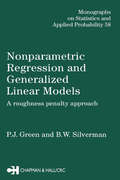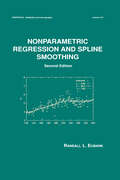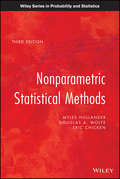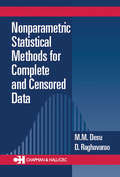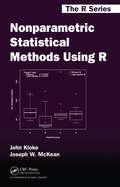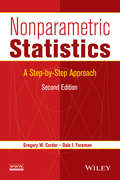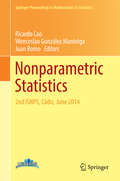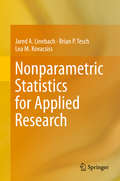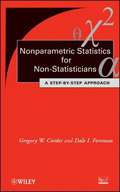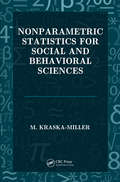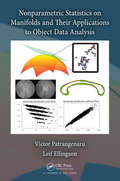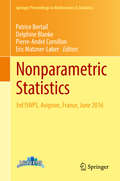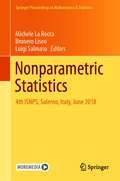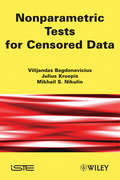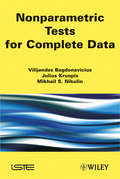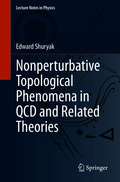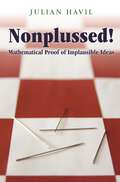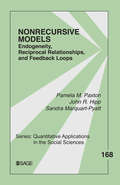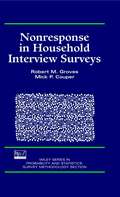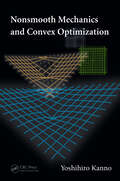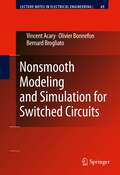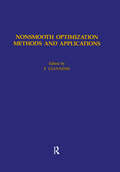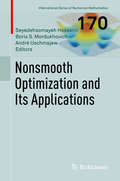- Table View
- List View
Nonparametric Regression and Generalized Linear Models: A roughness penalty approach (ISSN)
by P.J. Green Bernard. W. SilvermanNonparametric Regression and Generalized Linear Models focuses on the roughness penalty method of nonparametric smoothing and shows how this technique provides a unifying approach to a wide range of smoothing problems. The emphasis is methodological rather than theoretical, and the authors concentrate on statistical and computation issues. Real data examples are used to illustrate the various methods and to compare them with standard parametric approaches. The mathematical treatment is self-contained and depends mainly on simple linear algebra and calculus. This monograph will be useful both as a reference work for research and applied statisticians and as a text for graduate students.
Nonparametric Regression and Spline Smoothing (Statistics: A Series of Textbooks and Monographs)
by Randall L. EubankProvides a unified account of the most popular approaches to nonparametric regression smoothing. This edition contains discussions of boundary corrections for trigonometric series estimators; detailed asymptotics for polynomial regression; testing goodness-of-fit; estimation in partially linear models; practical aspects, problems and methods for co
Nonparametric Statistical Methods
by Douglas A. Wolfe Myles Hollander Eric ChickenPraise for the Second Edition"This book should be an essential part of the personal library of every practicing statistician."--Technometrics Thoroughly revised and updated, the new edition of Nonparametric Statistical Methods includes additional modern topics and procedures, more practical data sets, and new problems from real-life situations. The book continues to emphasize the importance of nonparametric methods as a significant branch of modern statistics and equips readers with the conceptual and technical skills necessary to select and apply the appropriate procedures for any given situation.Written by leading statisticians, Nonparametric Statistical Methods, Third Edition provides readers with crucial nonparametric techniques in a variety of settings, emphasizing the assumptions underlying the methods. The book provides an extensive array of examples that clearly illustrate how to use nonparametric approaches for handling one- or two-sample location and dispersion problems, dichotomous data, and one-way and two-way layout problems. In addition, the Third Edition features:The use of the freely available R software to aid in computation and simulation, including many new R programs written explicitly for this new editionNew chapters that address density estimation, wavelets, smoothing, ranked set sampling, and Bayesian nonparametricsProblems that illustrate examples from agricultural science, astronomy, biology, criminology, education, engineering, environmental science, geology, home economics, medicine, oceanography, physics, psychology, sociology, and space scienceNonparametric Statistical Methods, Third Edition is an excellent reference for applied statisticians and practitioners who seek a review of nonparametric methods and their relevant applications. The book is also an ideal textbook for upper-undergraduate and first-year graduate courses in applied nonparametric statistics.
Nonparametric Statistical Methods For Complete and Censored Data
by M.M. Desu D. RaghavaraoBalancing the "cookbook" approach of some texts with the more mathematical approach of others, Nonparametric Statistical Methods for Complete and Censored Data introduces commonly used non-parametric methods for complete data and extends those methods to right censored data analysis. Whenever possible, the authors derive their methodology from the
Nonparametric Statistical Methods Using R (Chapman & Hall/CRC Texts in Statistical Science #25)
by John Kloke Joseph McKeanPraise for the first edition:“This book would be especially good for the shelf of anyone who already knows nonparametrics, but wants a reference for how to apply those techniques in R.”-The American StatisticianThis thoroughly updated and expanded second edition of Nonparametric Statistical Methods Using R covers traditional nonparametric methods and rank-based analyses. Two new chapters covering multivariate analyses and big data have been added. Core classical nonparametrics chapters on one- and two-sample problems have been expanded to include discussions on ties as well as power and sample size determination. Common machine learning topics --- including k-nearest neighbors and trees --- have also been included in this new edition.Key Features: Covers a wide range of models including location, linear regression, ANOVA-type, mixed models for cluster correlated data, nonlinear, and GEE-type. Includes robust methods for linear model analyses, big data, time-to-event analyses, timeseries, and multivariate. Numerous examples illustrate the methods and their computation. R packages are available for computation and datasets. Contains two completely new chapters on big data and multivariate analysis. The book is suitable for advanced undergraduate and graduate students in statistics and data science, and students of other majors with a solid background in statistical methods including regression and ANOVA. It will also be of use to researchers working with nonparametric and rank-based methods in practice.
Nonparametric Statistical Methods Using R (Chapman And Hall/crc The R Ser. #25)
by John KlokeA Practical Guide to Implementing Nonparametric and Rank-Based ProceduresNonparametric Statistical Methods Using R covers traditional nonparametric methods and rank-based analyses, including estimation and inference for models ranging from simple location models to general linear and nonlinear models for uncorrelated and correlated responses. The a
Nonparametric Statistical Process Control
by Subhabrata Chakraborti Marien GrahamA unique approach to understanding the foundations of statistical quality control with a focus on the latest developments in nonparametric control charting methodologies Statistical Process Control (SPC) methods have a long and successful history and have revolutionized many facets of industrial production around the world. This book addresses recent developments in statistical process control bringing the modern use of computers and simulations along with theory within the reach of both the researchers and practitioners. The emphasis is on the burgeoning field of nonparametric SPC (NSPC) and the many new methodologies developed by researchers worldwide that are revolutionizing SPC. Over the last several years research in SPC, particularly on control charts, has seen phenomenal growth. Control charts are no longer confined to manufacturing and are now applied for process control and monitoring in a wide array of applications, from education, to environmental monitoring, to disease mapping, to crime prevention. This book addresses quality control methodology, especially control charts, from a statistician’s viewpoint, striking a careful balance between theory and practice. Although the focus is on the newer nonparametric control charts, the reader is first introduced to the main classes of the parametric control charts and the associated theory, so that the proper foundational background can be laid. Reviews basic SPC theory and terminology, the different types of control charts, control chart design, sample size, sampling frequency, control limits, and more Focuses on the distribution-free (nonparametric) charts for the cases in which the underlying process distribution is unknown Provides guidance on control chart selection, choosing control limits and other quality related matters, along with all relevant formulas and tables Uses computer simulations and graphics to illustrate concepts and explore the latest research in SPC Offering a uniquely balanced presentation of both theory and practice, Nonparametric Methods for Statistical Quality Control is a vital resource for students, interested practitioners, researchers, and anyone with an appropriate background in statistics interested in learning about the foundations of SPC and latest developments in NSPC.
Nonparametric Statistics
by Dale I. Foreman Gregory W. Corder"...a very useful resource for courses in nonparametric statistics in which the emphasis is on applications rather than on theory. It also deserves a place in libraries of all institutions where introductory statistics courses are taught." -CHOICEThis Second Edition presents a practical and understandable approach that enhances and expands the statistical toolset for readers. This book includes:New coverage of the sign test and the Kolmogorov-Smirnov two-sample test in an effort to offer a logical and natural progression to statistical powerSPSS® (Version 21) software and updated screen captures to demonstrate how to perform and recognize the steps in the various proceduresData sets and odd-numbered solutions provided in an appendix, and tables of critical valuesSupplementary material to aid in reader comprehension, which includes: narrated videos and screen animations with step-by-step instructions on how to follow the tests using SPSS; online decision trees to help users determine the needed type of statistical test; and additional solutions not found within the book.
Nonparametric Statistics
by Ricardo Cao Wenceslao González Manteiga Juan RomoThis volume collects selected, peer-reviewed contributions from the 2nd Conference of the International Society for Nonparametric Statistics (ISNPS), held in Cádiz (Spain) between June 11-16 2014, and sponsored by the American Statistical Association, the Institute of Mathematical Statistics, the Bernoulli Society for Mathematical Statistics and Probability, the Journal of Nonparametric Statistics and Universidad Carlos III de Madrid. The 15 articles are a representative sample of the 336 contributed papers presented at the conference. They cover topics such as high-dimensional data modelling, inference for stochastic processes and for dependent data, nonparametric and goodness-of-fit testing, nonparametric curve estimation, object-oriented data analysis, and semiparametric inference. The aim of the ISNPS 2014 conference was to bring together recent advances and trends in several areas of nonparametric statistics in order to facilitate the exchange of research ideas, promote collaboration among researchers from around the globe, and contribute to the further development of the field.
Nonparametric Statistics for Applied Research
by Jared A. Linebach Brian P. Tesch Lea M. KovacsissNon-parametric methods are widely used for studying populations that take on a ranked order (such as movie reviews receiving one to four stars). The use of non-parametric methods may be necessary when data have a ranking but no clear numerical interpretation, such as when assessing preferences. In terms of levels of measurement, non-parametric methods result in "ordinal" data. As non-parametric methods make fewer assumptions, their applicability is much wider than the corresponding parametric methods. In particular, they may be applied in situations where less is known about the application in question. Also, due to the reliance on fewer assumptions, non-parametric methods are more robust. Non-parametric methods have many popular applications, and are widely used in research in the fields of the behavioral sciences and biomedicine. This is a textbook on non-parametric statistics for applied research. The authors propose to use a realistic yet mostly fictional situation and series of dialogues to illustrate in detail the statistical processes required to complete data analysis. This book draws on a readers existing elementary knowledge of statistical analyses to broaden his/her research capabilities. The material within the book is covered in such a way that someone with a very limited knowledge of statistics would be able to read and understand the concepts detailed in the text. The "real world" scenario to be presented involves a multidisciplinary team of behavioral, medical, crime analysis, and policy analysis professionals work together to answer specific empirical questions regarding real-world applied problems. The reader is introduced to the team and the data set, and through the course of the text follows the team as they progress through the decision making process of narrowing the data and the research questions to answer the applied problem. In this way, abstract statistical concepts are translated into concrete and specific language. This text uses one data set from which all examples are taken. This is radically different from other statistics books which provide a varied array of examples and data sets. Using only one data set facilitates reader-directed teaching and learning by providing multiple research questions which are integrated rather than using disparate examples and completely unrelated research questions and data.
Nonparametric Statistics for Non-Statisticians
by Dale I. Foreman Gregory W. CorderA practical and understandable approach to nonparametric statistics for researchers across diverse areas of studyAs the importance of nonparametric methods in modern statistics continues to grow, these techniques are being increasingly applied to experimental designs across various fields of study. However, researchers are not always properly equipped with the knowledge to correctly apply these methods. Nonparametric Statistics for Non-Statisticians: A Step-by-Step Approach fills a void in the current literature by addressing nonparametric statistics in a manner that is easily accessible for readers with a background in the social, behavioral, biological, and physical sciences.Each chapter follows the same comprehensive format, beginning with a general introduction to the particular topic and a list of main learning objectives. A nonparametric procedure is then presented and accompanied by context-based examples that are outlined in a step-by-step fashion. Next, SPSS® screen captures are used to demonstrate how to perform and recognize the steps in the various procedures. Finally, the authors identify and briefly describe actual examples of corresponding nonparametric tests from diverse fields.Using this organized structure, the book outlines essential skills for the application of nonparametric statistical methods, including how to:Test data for normality and randomnessUse the Wilcoxon signed rank test to compare two related samplesApply the Mann-Whitney U test to compare two unrelated samplesCompare more than two related samples using the Friedman testEmploy the Kruskal-Wallis H test to compare more than two unrelated samplesCompare variables of ordinal or dichotomous scalesTest for nominal scale dataA detailed appendix provides guidance on inputting and analyzing the presented data using SPSS®, and supplemental tables of critical values are provided. In addition, the book's FTP site houses supplemental data sets and solutions for further practice.Extensively classroom tested, Nonparametric Statistics for Non-Statisticians is an ideal book for courses on nonparametric statistics at the upper-undergraduate and graduate levels. It is also an excellent reference for professionals and researchers in the social, behavioral, and health sciences who seek a review of nonparametric methods and relevant applications.
Nonparametric Statistics for Social and Behavioral Sciences
by M. Kraska-MIllerDescription: Incorporating a hands-on pedagogical approach, Nonparametric Statistics for Social and Behavioral Sciences presents the concepts, principles, and methods used in performing many nonparametric procedures. It also demonstrates practical applications of the most common nonparametric procedures using IBM's SPSS software. This text is the only current nonparametric book written specifically for students in the behavioral and social sciences. Emphasizing sound research designs, appropriate statistical analyses, and accurate interpretations of results, the text:Explains a conceptual framework for each statistical procedurePresents examples of relevant research problems, associated research questions, and hypotheses that precede each procedure Details SPSS paths for conducting various analysesDiscusses the interpretations of statistical results and conclusions of the researchWith minimal coverage of formulas, the book takes a nonmathematical approach to nonparametric data analysis procedures and shows students how they are used in research contexts. Each chapter includes examples, exercises, and SPSS screen shots illustrating steps of the statistical procedures and resulting output.
Nonparametric Statistics on Manifolds and Their Applications to Object Data Analysis
by Victor Patrangenaru Leif EllingsonA New Way of Analyzing Object Data from a Nonparametric ViewpointNonparametric Statistics on Manifolds and Their Applications to Object Data Analysis provides one of the first thorough treatments of the theory and methodology for analyzing data on manifolds. It also presents in-depth applications to practical problems arising in a variety of fields
Nonparametric Statistics: 3rd ISNPS, Avignon, France, June 2016 (Springer Proceedings in Mathematics & Statistics #250)
by Patrice Bertail Delphine Blanke Pierre-André Cornillon Eric Matzner-LøberThis volume presents the latest advances and trends in nonparametric statistics, and gathers selected and peer-reviewed contributions from the 3rd Conference of the International Society for Nonparametric Statistics (ISNPS), held in Avignon, France on June 11-16, 2016. It covers a broad range of nonparametric statistical methods, from density estimation, survey sampling, resampling methods, kernel methods and extreme values, to statistical learning and classification, both in the standard i.i.d. case and for dependent data, including big data. The International Society for Nonparametric Statistics is uniquely global, and its international conferences are intended to foster the exchange of ideas and the latest advances among researchers from around the world, in cooperation with established statistical societies such as the Institute of Mathematical Statistics, the Bernoulli Society and the International Statistical Institute. The 3rd ISNPS conference in Avignon attracted more than 400 researchers from around the globe, and contributed to the further development and dissemination of nonparametric statistics knowledge.
Nonparametric Statistics: 4th ISNPS, Salerno, Italy, June 2018 (Springer Proceedings in Mathematics & Statistics #339)
by Luigi Salmaso Michele La Rocca Brunero LiseoHighlighting the latest advances in nonparametric and semiparametric statistics, this book gathers selected peer-reviewed contributions presented at the 4th Conference of the International Society for Nonparametric Statistics (ISNPS), held in Salerno, Italy, on June 11-15, 2018. It covers theory, methodology, applications and computational aspects, addressing topics such as nonparametric curve estimation, regression smoothing, models for time series and more generally dependent data, varying coefficient models, symmetry testing, robust estimation, and rank-based methods for factorial design. It also discusses nonparametric and permutation solutions for several different types of data, including ordinal data, spatial data, survival data and the joint modeling of both longitudinal and time-to-event data, permutation and resampling techniques, and practical applications of nonparametric statistics.The International Society for Nonparametric Statistics is a unique global organization, and its international conferences are intended to foster the exchange of ideas and the latest advances and trends among researchers from around the world and to develop and disseminate nonparametric statistics knowledge. The ISNPS 2018 conference in Salerno was organized with the support of the American Statistical Association, the Institute of Mathematical Statistics, the Bernoulli Society for Mathematical Statistics and Probability, the Journal of Nonparametric Statistics and the University of Salerno.
Nonparametric Tests for Censored Data (Wiley-iste Ser.)
by Julius Kruopis Mikhail S. Nikulin Vilijandas BagdonaviciusThis book concerns testing hypotheses in non-parametric models. Generalizations of many non-parametric tests to the case of censored and truncated data are considered. Most of the test results are proved and real applications are illustrated using examples. Theories and exercises are provided. The incorrect use of many tests applying most statistical software is highlighted and discussed.
Nonparametric Tests for Complete Data
by Julius Kruopis Mikhail S. Nikulin Vilijandas BagdonaviciusThis book concerns testing hypotheses in non-parametric models. Classical non-parametric tests (goodness-of-fit, homogeneity, randomness, independence) of complete data are considered. Most of the test results are proved and real applications are illustrated using examples. Theories and exercises are provided. The incorrect use of many tests applying most statistical software is highlighted and discussed.
Nonperturbative Topological Phenomena in QCD and Related Theories (Lecture Notes in Physics #977)
by Edward ShuryakThis book introduces a variety of aspects in nonperturbative Quantum Chromodynamics (QCD), focusing on the topological objects present in gauge theories. These objects, like magnetic monopoles, instantons, instanto-dysons, sphalerons, QCD flux tubes, etc, are first introduced individually and, later, treated collectively. As ensembles, they produce various phenomena that can be modeled numerically in lattice gauge theories and such collective effects, produced on the lattice, are extensively discussed in some chapters. In turn, the notion of duality, which is crucial in modern field/string theories, is elucidated by taking into consideration the electric-magnetic duality, the Poisson duality, and the AdS/CFT duality. This monograph is based on various lectures given by Edward Shuryak at Stony Brook during the last three decades and it is meant for advanced graduate students and young researchers in theoretical and mathematical physics who are willing to consolidate their knowledge in the topological phenomena encountered in fundamental QCD research.
Nonplussed!: Mathematical Proof of Implausible Ideas
by Julian HavilMath—the application of reasonable logic to reasonable assumptions—usually produces reasonable results. But sometimes math generates astonishing paradoxes—conclusions that seem completely unreasonable or just plain impossible but that are nevertheless demonstrably true. Did you know that a losing sports team can become a winning one by adding worse players than its opponents? Or that the thirteenth of the month is more likely to be a Friday than any other day? Or that cones can roll unaided uphill? In Nonplussed!—a delightfully eclectic collection of paradoxes from many different areas of math—popular-math writer Julian Havil reveals the math that shows the truth of these and many other unbelievable ideas.Nonplussed! pays special attention to problems from probability and statistics, areas where intuition can easily be wrong. These problems include the vagaries of tennis scoring, what can be deduced from tossing a needle, and disadvantageous games that form winning combinations. Other chapters address everything from the historically important Torricelli's Trumpet to the mind-warping implications of objects that live on high dimensions. Readers learn about the colorful history and people associated with many of these problems in addition to their mathematical proofs.Nonplussed! will appeal to anyone with a calculus background who enjoys popular math books or puzzles.
Nonrecursive Models: Endogeneity, Reciprocal Relationships, and Feedback Loops
by Pamela M. Paxton John R. Hipp Sandra Marquart-PyattNonrecursive Models is a clear and concise introduction to the estimation and assessment of nonrecursive simultaneous equation models. This unique monograph gives practical advice on the specification and identification of simultaneous equation models, how to assess the quality of the estimates, and how to correctly interpret results.
Nonresponse in Household Interview Surveys
by Robert M. Groves Mick P. CouperA comprehensive framework for both reduction of nonresponse and postsurvey adjustment for nonresponseThis book provides guidance and support for survey statisticians who need to develop models for postsurvey adjustment for nonresponse, and for survey designers and practitioners attempting to reduce unit nonresponse in household interview surveys. It presents the results of an eight-year research program that has assembled an unprecedented data set on respondents and nonrespondents from several major household surveys in the United States.Within a comprehensive conceptual framework of influences on nonresponse, the authors investigate every aspect of survey cooperation, from the influences of household characteristics and social and environmental factors to the interaction between interviewers and householders and the design of the survey itself.Nonresponse in Household Interview Surveys: * Provides a theoretical framework for understanding and studying household survey nonresponse * Empirically explores the individual and combined influences of several factors on nonresponse * Presents chapter introductions, summaries, and discussions on practical implications to clarify concepts and theories * Supplies extensive references for further study and inquiryNonresponse in Household Interview Surveys is an important resource for professionals and students in survey methodology/research methods as well as those who use survey methods or data in business, government, and academia. It addresses issues critical to dealing with nonresponse in surveys, reducing nonresponse during survey data collection, and constructing statistical compensations for the effects of nonresponse on key survey estimates.
Nonsmooth Mechanics and Convex Optimization
by Yoshihiro Kanno"This book concerns matter that is intrinsically difficult: convex optimization, complementarity and duality, nonsmooth analysis, linear and nonlinear programming, etc. The author has skillfully introduced these and many more concepts, and woven them into a seamless whole by retaining an easy and consistent style throughout. The book is not all the
Nonsmooth Modeling and Simulation for Switched Circuits
by Vincent Acary Bernard Brogliato Olivier BonnefonNonsmooth Modeling and Simulation for Switched Circuits concerns the modeling and the numerical simulation of switched circuits with the nonsmooth dynamical systems (NSDS) approach, using piecewise-linear and multivalued models of electronic devices like diodes, transistors, switches. Numerous examples (ranging from introductory academic circuits to various types of power converters) are analyzed and many simulation results obtained with the INRIA open-source SICONOS software package are presented. Comparisons with SPICE and hybrid methods demonstrate the power of the NSDS approach. Nonsmooth Modeling and Simulation for Switched Circuits is intended to researchers and engineers in the field of circuits simulation and design, but may also attract applied mathematicians interested by the numerical analysis for nonsmooth dynamical systems, as well as researchers from Systems and Control.
Nonsmooth Optimization Methods
by F. GiannessiNonsmooth Optimization Methods and Applications provides an overview of this branch of mathematics, concentrating on the interaction between the theory and its applications.
Nonsmooth Optimization and Its Applications (International Series of Numerical Mathematics #170)
by Boris S. Mordukhovich Seyedehsomayeh Hosseini André UschmajewSince nonsmooth optimization problems arise in a diverse range of real-world applications, the potential impact of efficient methods for solving such problems is undeniable. Even solving difficult smooth problems sometimes requires the use of nonsmooth optimization methods, in order to either reduce the problem’s scale or simplify its structure. Accordingly, the field of nonsmooth optimization is an important area of mathematical programming that is based on by now classical concepts of variational analysis and generalized derivatives, and has developed a rich and sophisticated set of mathematical tools at the intersection of theory and practice.This volume of ISNM is an outcome of the workshop "Nonsmooth Optimization and its Applications," which was held from May 15 to 19, 2017 at the Hausdorff Center for Mathematics, University of Bonn. The six research articles gathered here focus on recent results that highlight different aspects of nonsmooth and variational analysis, optimization methods, their convergence theory and applications.
